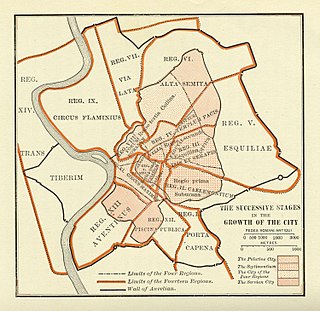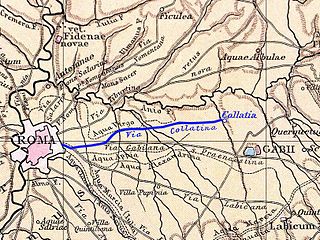Corniculum was an ancient town in Latium in central Italy.

Latium is the region of central western Italy in which the city of Rome was founded and grew to be the capital city of the Roman Empire. Latium was originally a small triangle of fertile, volcanic soil on which resided the tribe of the Latins or Latians. It was located on the left bank of the River Tiber, extending northward to the River Anio and southeastward to the Pomptina Palus as far south as the Circeian promontory. The right bank of the Tiber was occupied by the Etruscan city of Veii, and the other borders were occupied by Italic tribes. Subsequently, Rome defeated Veii and then its Italic neighbours, expanding Latium to the Apennine Mountains in the northeast and to the opposite end of the marsh in the southeast. The modern descendant, the Italian Regione of Lazio, also called Latium in Latin, and occasionally in modern English, is somewhat larger still, but not as much as double the original Latium.

Italy, officially the Italian Republic, is a country in Southern and Western Europe. Located in the middle of the Mediterranean Sea, Italy shares open land borders with France, Switzerland, Austria, Slovenia and the enclaved microstates San Marino and Vatican City. Italy covers an area of 301,340 km2 (116,350 sq mi) and has a largely temperate seasonal and Mediterranean climate. With around 61 million inhabitants, it is the fourth-most populous EU member state and the most populous country in Southern Europe.
In Rome's early semi-legendary history, the town was part of the Latin League, which went to war with Rome during the reign of Rome's king Lucius Tarquinius Priscus. Corniculum was one of a number of towns captured by Tarquinius. [1]

The Latin League was an ancient confederation of about 30 villages and tribes in the region of Latium near the ancient city of Rome, organized for mutual defense. The term "Latin League" is one coined by modern historians with no precise Latin equivalent.

In historiography, ancient Rome is Roman civilization from the founding of the Italian city of Rome in the 8th century BC to the collapse of the Western Roman Empire in the 5th century AD, encompassing the Roman Kingdom, Roman Republic and Roman Empire until the fall of the western empire. The civilization began as an Italic settlement in the Italian Peninsula, conventionally founded in 753 BC, that grew into the city of Rome and which subsequently gave its name to the empire over which it ruled and to the widespread civilisation the empire developed. The Roman empire expanded to become one of the largest empires in the ancient world, though still ruled from the city, with an estimated 50 to 90 million inhabitants and covering 5.0 million square kilometres at its height in AD 117.

Lucius Tarquinius Priscus, or Tarquin the Elder, was the legendary fifth king of Rome from 616 to 579 BC. His wife was Tanaquil.
Livy also records that one of the leading men of Corniculum, named Servius Tullius, was slain in the capture of the town, and that his pregnant wife was taken captive to Rome, but was exempted from slavery by the Roman queen Tanaquil on account of her rank, and was given a place in the king's household. She gave birth to a son, Servius Tullius, who later married Tarqunius' daughter, and succeeded him as king of Rome. [2]

Tanaquil was the queen of Rome by marriage to Tarquinius Priscus, fifth king of Rome.

Servius Tullius was the legendary sixth king of Rome, and the second of its Etruscan dynasty. He reigned 575–535 BC. Roman and Greek sources describe his servile origins and later marriage to a daughter of Lucius Tarquinius Priscus, Rome's first Etruscan king, who was assassinated in 579 BC. Servius is said to have been the first Roman king to accede without election by the Senate, having gained the throne by popular support; and the first to be elected by the Senate alone, without reference to the people.






